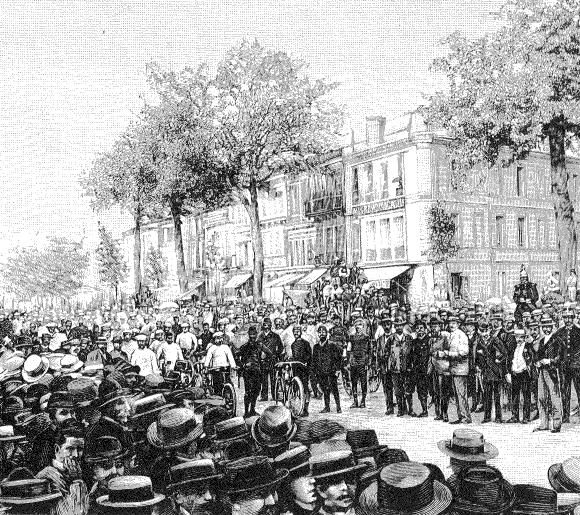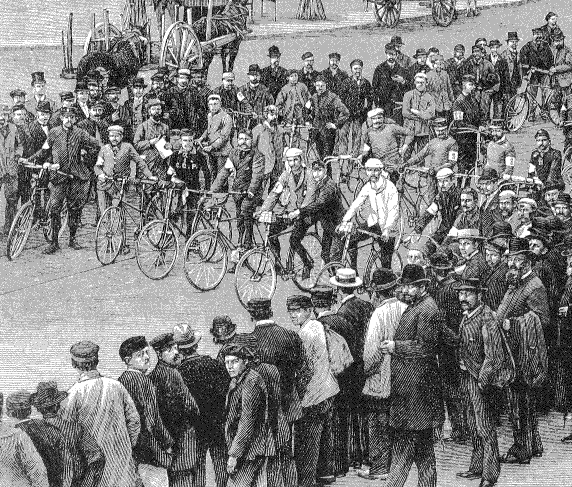Le développement progressif du sport masculin en France
(1890-1880)
Le Vélocipéde Illustré : publicity and the development of a sport.
Male cycling sport can be approached by glancing at the Tour de France, the track races organized at the Vélodrome d'hiver in Paris in the inter-war decades, and other emblematic events in racing and competition such as the Bordeaux–Paris (raced annually between 1891 and 1988) and Paris–Brest–Paris (staged every ten years from 1891 to 1951) organized by major cycling clubs and sports newspapers. As well as the novelty of a technology of personal mobility and transport, and as an instrument of leisure for the upper classes, cycling was popularized in the early decades through its adoption by individuals and newspapers as a form of competition. Cycle races were the principal means by which the technology and the activity of cycling in general were publicized, and in France in particular, a professionalized racing community was soon established.
The first properly documented races took place in 1868, in Paris at the Parc de Saint-Cloud (31 May 1868), in Toulouse (27 July 1868) and in Bordeaux (2 November 1868). Many other races were organized during 1868 in the Paris region (either at the Paris hippodrome or at La Varenne, Charenton, Pantin, Le Raincy or Enghien) and also in small towns as far removed from the modernity and cosmopolitanism of Paris as Cognac, in the sleepy department of Charente-inférieure.
Les courses à vélo
Course annuelle vélocipédique de Bordeaux à Paris. Le départ, à Bordeaux, le 27 mai 1893, à 8 h de matin. (D’après une photographie de M. l’anajou.
Between these first beginnings of cycling competition and the Franco-Prussian war, racing flourished. The Véloce-club de Paris staged frequent races in Paris (including a ‘Tour de Paris’) and other clubs organized competitions in towns such as Angers, Besançon, Carpentras, Chartres, Lille, Lyon and Marseille. The most important race of the period was undoubtedly the Paris–Rouen of 7 November 1869. Paris–Rouen was sponsored by the recently founded sporting newspaper Le Vélocipède illustré, which was exploiting the popularity of cycling as pastime and spectacular sport. The enthusiasm for racing was reflected in the 300 entries to compete in the race, including some from women, although only 100 competitors actually set off. Paris–Rouen was intended by its originator, the celebrated journalist Richard Lesclide, to demonstrate the practical usefulness of the bicycle as a means of travel between two important cities.
Paris–Rouen 1869
Champions : James Moore (right) and Jean-Eugène-André Castera
Dauncy, H. (2012). French Cycling: A Social and Cultural History. Liverpool Press Scholarship Online. Pg 30.
« Cependant, à part les spécialistes, le cyclisme intéresse-t-il le grand public? Rien n'est moins sûr. D'autre part, les victoires changeantes et diverses des uns et des autres en vitesse comme en fond le prouvent, ce sport n'a pas atteint la maturité, sinon la perfection, où chacun se consacre à la forme d'épreuve pour laquelle il présente le plus d'aptitude. »
By December 1876 the frequency of race meetines in Paris led to the creation of an early cycling ‘federation’, the Union vélocipédique parisienne, intended to instil some order into the planning of races. Four years later the desire for a centralizing influence saw the birth of the Union Vélocipédique de France in February 1881, and the first races of the French national championships, held over the distance of 10 km at the Place du Carrousel, Paris. Racing in the 1880s continued to develop, but seemed to lack the excitement of its founding years in the late 1860s. Commenting on this period, Durry notes:
Union Vélocipédique de France
© F. Appel Paris.
La Banque de l'image.
The racing of the period was a sport that was trying to find its feet. It was only in the 1890s that cycling as a sport became a proper commercial spectacle, with road and track races attracting huge audiences and involving considerable financial stakes for riders, managers, trainers, promoters, manufacturers and newspapers. Although cycle races of the 1870s and 1880s were reported in the general press as well as in the nascent specialized cycling press, public interest in what was generally held to be a pastime for the privileged few was far from what it would become in the hey-day of racing during the 1890s, and from the creation of the Tour de France in 1903. Even if some racers in the 1880s – such as Charles Terront – were of a modest background and tempted into professional riding by the rewards on offer, for the general population cycling still seemed an activity reserved for the well-off, and despite the interest of its speed and mechanical modernity, something of only tangential interest to the masses.
Charles Terront in the activity of the well-off
The first phase of maturity, at least, was to be gained in the 1890s, as seminal races such as Bordeaux–Paris and Paris–Brest–Paris rewrote the rules of road racing, and the rise of vélodromes fuelled public enthusiasm for track races.
"La course Bordeaux–Paris”, 1891
© Gallica
The Tour is cycling, but cycling is not just the Tour.
« le Tour de France s'est enraciné dans les rituels nationaux. Une institution devenue si légitime, même, qu'elle semble être sans âge: un spectacle aux origines oubliées. C'est que l'épreuve est peut-être plus qu'une course, elle s'adresse à la conscience collective, aux références communautaires, autant qu'à la curiosité sportive. Elle joue avec la géographie, les provinces, les frontières. Elle met en scène un espace-nation, un décor fait du territoire lui-même.»
Vignorello
Dauncy, H. (2012). French Cycling: A Social and Cultural History. Liverpool Press Scholarship Online. Pg 2
© LE QUOTIDIEN COMMUNISTE
Le Tour de France , a national, social portrait
Its creation in 1903 reveals the role of cycling as a driver of professional sport and the importance of cycle sport in developing the French media of the period. The celebratory nature of the first post-war Tour run in 1947 by L'Equipe, is a particular example of how the ‘national institution’ helped define the new France throughout the 20th century.
In a period of imperial expansion and nationalistic rivalries, sport was also becoming increasingly internationalized, as interest in confrontations between nations or their representative champions fascinated the sporting public and stimulated the appetite of the sporting media. As sport internationalized, the need for common rules and regulations became increasingly pressing, to allow national records and competitions to be sensibly comparable and so that international competitions could be staged fairly. The Union Cycliste Internationale (UCI) was formed on 14 April 1900, in Paris. The UCI has had a chequered history, with its role being constantly challenged and debated. For a long time, the UCI struggled to assert any kind of authority over the world of professional and amateur cycling, faced with the fixed commercial, industrial and media interests of the traditional sponsors in the sport. Countries such as Belgium, Spain, Italy and France, which had considerable experience of professional racing extending back to the 1870s and beyond, had evolved strong national organizing bodies that were unwilling to make compromises at the international level.
Union Cyclist International
Members of the UCI in 1909















